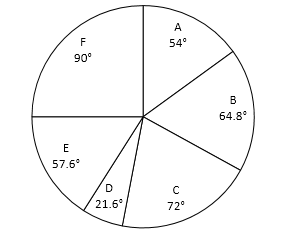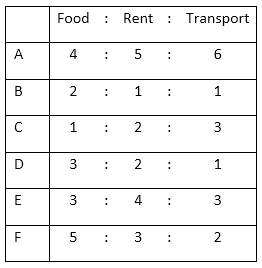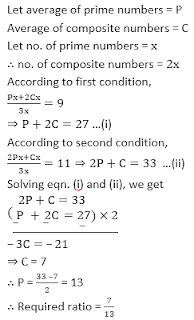
Directions (1-5): Pie chart given below shows expenditure of six persons and table given below shows ratio between expenditure on three different products by each person. Study the data carefully and answer the following questions.
Note- Expenditure is considered for food, rent and transportation only.
Q1. Find the difference between expenditure of B on Food to that of C’s on food if expenditure of ‘F’ on Food is Rs. 6750.
Q2. A’s expenditure on transport is what percent more than E’s expenditure on transport?
Q3. Find the average expenditure of A, B and C together on transport if average expenditure of D, E and F together on transport is Rs. 4860.
Q4. Expenditure of B and C on Rent is how much more than expenditure of D and E on Rent if expenditure of F on Rent is Rs. 8100.
Q5. If A’s expenditure on rent is Rs. 8100, then find total expenditure of all six persons together? (in lakh)
Directions (6-10): What should come in place of the question mark (?) in the following question?
Q6. ![]()
Q11. A and B started a business in partnership with the investment of Rs. 27000 and Rs. 36000 respectively, after 4 month A withdraw 5000 Rs. and B added 6000 Rs. more and C joined with 35000 Rs. if after one year they get a total profit of Rs. 130500, then find the profit share of C?
Q12. Sheetal and Sakshi two working employee of Add 247 got salaries per month Rs 24000 and Rs 32000 respectively. Both invest 50% and 40% of their salaries in mutual funds and after a year they got a total profit from their investment as Rs 12400, then find the profit of Sakshi obtained from mutual funds.
Q13. P being a working partner gets 10% of the profit as salary, the remaining is shared between P, Q, R in the ratio 2 : 3 : 4, If P gets Rs. 300000, find the share of Q.
Q14. In a set of prime and composite numbers, the composite numbers are twice the number of prime numbers and the average of all the numbers of the set is 9. If the number of prime numbers and composite numbers are exchanged then the average of the set of numbers is increased by 2 and during the exchange of the numbers the average of the prime numbers and composite numbers individually remained constant, then find the ratio of the average of composite numbers to the average of prime numbers (initially).
Q15. Ages of A, B, and C are in geometric progression while ages of A, Q and R is in arithmetic progression. If ratio between common difference of arithmetic progression formed by second group (A, Q, R) and common ratio of geometric progression formed by first group (A, B and C) is 2: 1 and total sum of ages of first group (A, B, C) is 182 and total sum of second group (A, Q, R) is 60 then which of the following options given below will be the ages of A, B, C respectively.
- Quantitative Aptitude Study Notes for Bank Exams
- 100 MCQs Data Interpretation | Download Free PDF's of DI
- Quantitative Aptitude Questions for all Competitive Exams
























 GA Capsule for SBI Clerk Mains 2025, Dow...
GA Capsule for SBI Clerk Mains 2025, Dow...
 The Hindu Review October 2022: Download ...
The Hindu Review October 2022: Download ...
 RRB NTPC Exam Date 2025 Soon, Check Expe...
RRB NTPC Exam Date 2025 Soon, Check Expe...





